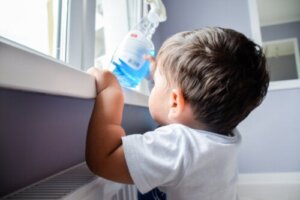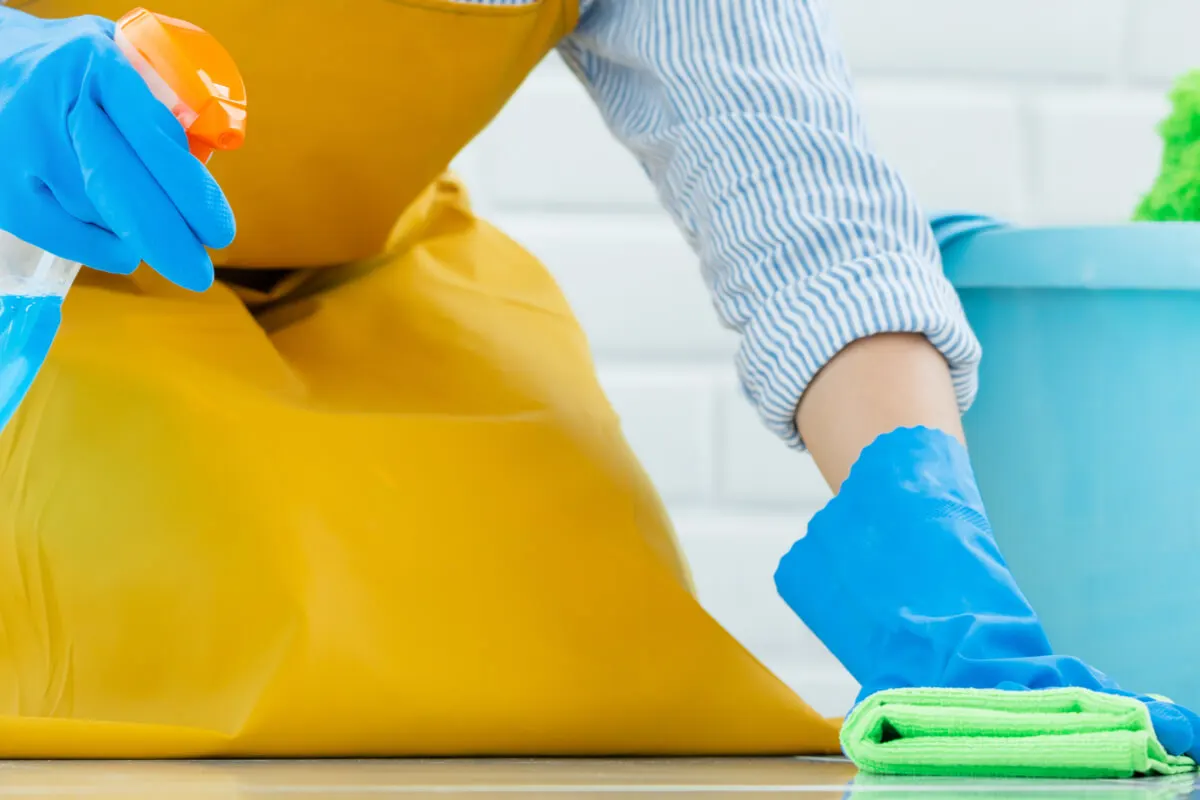What Are the Symptoms of Bleach Poisoning?


Reviewed and approved by the nurse Leidy Mora Molina
The symptoms of bleach poisoning will depend on how the contact with the substance was made – i.e. whether it was inhaled, swallowed, or splashed in the eyes. In this sense, there may be burning and reddening of the skin or mucous membranes, nausea, a cough, a sore throat, and even arrhythmia.
Bleach is widely used for cleaning at home. However, it should be used with care, since its main component is sodium hypochlorite.
In this article, we’ll explain the most frequent symptoms of bleach poisoning, how to act if we inhale or ingest it by accident, and how to use this product correctly in order to prevent domestic accidents.
What is bleach and what is it used for?
Bleach, or sodium hypochlorite, is an aqueous solution made from this chemical substance. This chemical can be present in cleaning and laundry supplies, whitening materials, and water purifiers.
Its concentrations in household products vary from 3% to 6%. However, the types of bleach used in swimming pools can reach up to 10%.
Laundry bleach is useful in household cleaning when applied in the places where bacteria accumulate most, from the kitchen and bathroom to bedrooms and the basement. It’s also used to disinfect laboratory materials (non-metallic or not containing organic material), as well as various surfaces or fomites in sanitary spaces.
Due to its characteristics, it’s considered suitable for eliminating microbes, fungi, and other microorganisms, thus achieving disinfection and minimizing the risk of contracting or spreading diseases.
We think you may be interested in reading this, too: Why Shouldn’t You Mix Vinegar with Bleach?
The symptoms of bleach poisoning
Despite all these cleaning benefits, if it’s not used correctly, bleach can be dangerous. This is not only for the person who is handling it, but for children and even pets in the house.
It’s worth noting that, in the home, misuse of bleach can also result from mixing sodium hypochlorite with other substances, such as hydrochloric acid or ammonia. This is one of the frequent mistakes made when cleaning with bleach.
On the other hand, the symptoms of bleach poisoning may vary depending on the form of contact, the area of the body exposed, the concentration of the substance, as well as the time of exposure.

Bleach poisoning: Skin contact
In household products, sodium hypochlorite is at 5%, and sometimes less. Even in these aqueous solutions, bleach can irritate the skin of sensitive people, causing burning or redness.
However, when it’s present in higher concentrations, hypochlorite behaves like an alkaline caustic, which becomes corrosive. It causes burning and blistering of the affected area.
Interestingly, 0.05% bleach baths are used for the treatment of atopic dermatitis. This appears to have anti-inflammatory effects and helps to improve symptoms by reducing the concentration of bacteria such as Staphylococcus aureus, without resorting to corticosteroids or topical antibiotics. However, this must only be done under medical supervision and with medical-grade bleach.
Bleach poisoning: Eye contact
In the eyes and other mucous membranes, when combined with proteins and fats, the chemical action of sodium hypochlorite on the tissues is direct. Burns, burning, and sensations of intense pain may occur. However, in less severe cases redness, inflammation and tearing may also occur.
Inhalation
As mentioned, the mixture of bleach with other products, whether domestic or industrial, produces a reaction in which chlorine vapors are released.
Inhalation of these vapors may trigger various reactions:
- At one part per million (1 ppm) can cause irritation of the nasal, ocular, and pharyngeal mucosa in sensitive individuals, as well as runny nose, coughing, choking sensation, tearing, and dryness.
- At 30 ppm, even in short exposures, it can cause chest pain, nausea and vomiting, altered respiratory rhythm, coughing, headache.
- At 40 ppm or more, glottis edema, pleural pain, obstructive bronchitis, and difficulty in breathing may occur.
- In the most severe cases, hypoxemia and pulmonary edema occur.
Ingestion
In the case of ingestion, whether accidental or intentional, the symptoms of bleach poisoning will also depend on the concentration, as well as the amount ingested. With 5 % household products, the following signs occur:
- Stomach pain
- Nausea and vomiting
- Ulcers in the mucous membranes
- Low blood pressure
- Burns in the esophagus, mouth, or throat
Even though a 2018 review notes an average of 45,000 annual cases of bleach poisoning in the United States, only about 1 death is reported every four years.
Like this article? You may also like to read: 5 Cheap and Easy Natural Ways to Bleach Towels
What to do in the case of bleach poisoning?
If someone accidentally ingests bleach, they should first and foremost remain calm and contact a doctor. Under no circumstances should vomiting be induced, as this could further irritate the mucous membranes.
Nor is it recommended to use a nasogastric tube, do an intestinal lavage, administer activated charcoal, or neutralize using alkalis or acids. At most, the mouth should be rinsed with water.
Also, if swallowing difficulties are not experienced, water can be taken slowly to dilute the concentration of the product. Or even small sips of milk.
However, this is not advisable if more than an hour has passed after ingestion and the person is unable to swallow. The same is true if attempts to swallow trigger coughing fits.
In people without digestive symptoms, a gastric protector may be recommended. Those who present symptoms should undergo some medical tests and continue under treatment for several days.
On the other hand, when hypochlorite has come into contact with the skin, all clothing should be removed and the affected area should be washed with plenty of water. The physiological solution can be used on the mucous membranes of the eyes.
If a child is suspected of having ingested bleach, he/she should be taken immediately to a hospital emergency room.
All cases of poisoning with bleach require immediate medical assistance.
How to prevent bleach poisoning?
Everything that we’ve talked about so far does not mean that we should stop using this product. However, we should take some important measures to prevent bleach poisoning.
Among these measures, we have the following:
- Open the windows before starting to clean so that the space is ventilated.
- Wear a mask or chinstrap to reduce the chance of inhalation.
- Wear protective clothing. Pants and shirts with long sleeves are best to avoid skin contact.
- Wear thick work gloves.
Finally, do not under any circumstances mix bleach with any other cleaning product. And last but not least, always make sure to store this and other substances out of the reach of children and pets.
All cited sources were thoroughly reviewed by our team to ensure their quality, reliability, currency, and validity. The bibliography of this article was considered reliable and of academic or scientific accuracy.
- Echeverría Valencia G. Determinación fúngica y bacteriana de superficies, posterior a la limpieza con hipoclorito de sodio al 10%. Ciencias Clínicas. 2018; 1(1): 21-24.
- Maarouf M, Shi V. Bleach for Atopic Dermatitis. Dermatitis: 2018; 29(3): 120-126.
- Mattos G, Lopes D, Mamede R, et al. Effects of time of contact and concentration of caustic agent on generation of injuries. Laryngoscope, 2006; 116: 456-460.
- Núñez O, González-Asanza C, de la Cruz G, et al. Estudio de los factores predictivos de lesiones digestivas graves tras la ingesta de cáusticos. Med. Clin. (Barc.). 2004; 123: 611-614.
- Rey de Castro J. Bronquitis crónica obstructiva. Fronteras med. 1994; II(3): 140-51.
- Slaughter R, Watts M, Allister J, Grieve J, Schep L. The clinical toxicology of sodium hypochlorite, Clinical Toxicology. 2019; 57(5): 303-311.
- Saracco S. Recomendaciones para la atención de las intoxicaciones por lavandina cloro. Departamento de Toxicología del Gobierno de Mendoza. Sin fecha. Documento en línea. URL disponible en: https://www.mendoza.gov.ar/salud/wp-content/uploads/sites/16/2016/08/Recomendaciones-para-la-Atenci%C3%B3n-de-Intoxicaciones-por-Lavandina-Cloro.pdf
- Turner A, Robinson P. Respiratory and gastrointestinal complications of caustic ingestion in children. Emer. Med. J. 2005; 22: 359-361.
This text is provided for informational purposes only and does not replace consultation with a professional. If in doubt, consult your specialist.








